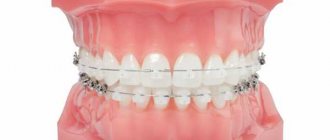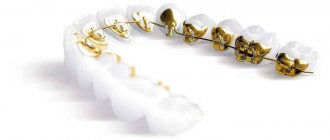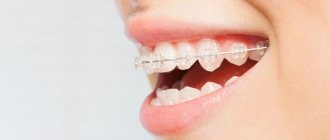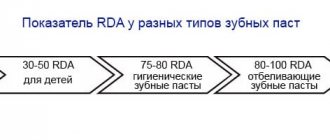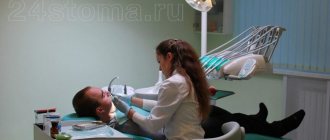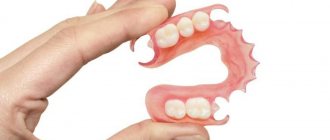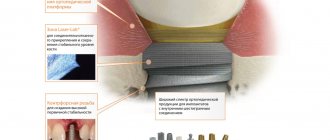For many patients, the decision to correct their bite with braces is not easy. The main reason is that it is difficult to decide to wear such a system, which is constantly in sight, for one or two years. Incognito lingual braces can solve this problem. Their peculiarity is that they are attached to the inside of the dentition and are therefore invisible to others.
Incognito braces are installed on the inside of the teeth
This braces system was invented in the early 2000s in Germany and quickly gained popularity. But before planning a visit to the dentist, it is worth studying the pros and cons, as well as contraindications to installing Incognito braces.
What are lingual braces?
In modern dentistry, there are two main groups of braces: vestibular and lingual. The first ones are installed on the outside of the dentition, so that orthodontic treatment will not remain invisible to others even if spectacular translucent systems are installed. Lingual braces are an orthodontic system that is fixed to the inside of the teeth. This is the main advantage: due to their location, the locks remain completely invisible to prying eyes.
Photos before and after treatment with lingual braces
The photographs below show a mild clinical case where treatment with lingual braces lasted 9 months.
Wearing and care
Since Incognito is attached to the internal area of the organs, treatment of them should be more careful, and care should be more thorough, since poor hygiene is the main enemy of such treatment. To ensure that dental health does not suffer after correction of defects, the following requirements must be met:
- To make cleaning the product easier, use devices specially designed for this purpose - brushes, mono-beam brushes, thread for treating braces. It will be useful to purchase an irrigator;
- do not ignore scheduled visits to the dentist, this minimizes the risk of developing serious inflammatory processes and infections, and if they occur, it is an opportunity to quickly localize the disease;
- Regularly use mouthwashes that contain antibacterial components.
Types of lingual braces
Today there are many varieties of internal braces from different manufacturers. The choice of devices is quite large, so everyone can find the best option. All of them effectively help eliminate crooked teeth and cope with malocclusion completely unnoticed by others, but each lingual system has its own characteristics. The devices vary depending on materials, manufacturing technology and cost. Let's look at the most popular invisible lingual braces.
STB
Bracket system from Ormco, USA. It has a round shape and is made of metal. The thickness of STB lingual braces is 1.5 millimeters, while they provide precise correction of the dentition and comfort in use. The model does not have the main disadvantage of conventional lingual appliances - large staples on the side of the tongue. STB lingual braces are quite easy to care for, so they are perfect even for children. The device has virtually no effect on pronunciation.
Incognito
An innovative German brace system made from a platinum-gold alloy is manufactured by Top Service based on an impression of the patient’s teeth: first, a 3D model of the future device is designed, taking into account the smallest nuances of the jaw structure, after which the lingual system is produced by milling using special CAD/CAM technology. Invisible lingual braces Incognito are hypoallergenic and ideal for any clinical case.
Win
Another model produced by Top Service. However, unlike Incognito lingual braces, these internal braces are miniature in size and flattened in shape. Standard Win lingual braces do not cause discomfort while wearing and are practically not felt. The system is ideally adapted to the dental surface and is suitable for eliminating pathologies of any complexity. In addition, the improved production technology of the device has made it possible to significantly reduce the cost of the model in comparison with the Incognito lingual brace system.
2D
Modern invisible braces from the German manufacturer Forestadent. They have a perfectly polished surface and a small thickness, which allows you to maintain diction and maintain wearing comfort. Also, one of the advantages of 2D lingual braces is the price, and in terms of efficiency they are not inferior to other models.
In Ovation L
Lingual metal brace system from one of the largest companies in the dental market, Dentsply. Main advantages: accessibility and versatility. The device is made from an alloy of cobalt and nickel and is sold completely ready, eliminating the need for the patient to wait. The In Ovation L system is suitable for those who will experience tooth movement of up to six millimeters.
Features of the Incognito braces device
The Incognito design is fixed on the tooth surface from the tongue side. There is not much space in this space, so the system must be compact. At the same time, it is necessary to ensure reliability and strength for a thin product, so specially developed alloys are used in their manufacture. The devices are characterized by high resistance to deformation, cracks and wear.
Installing lingual braces on teeth
The procedure for installing internal braces is not particularly different from fixing traditional braces. First of all, the patient will undergo a preparatory stage, during which he will undergo diagnostics, professional hygiene procedures and oral sanitation (a set of medical procedures to eliminate diseases and inflammation in the oral cavity).
Based on the diagnostic results, 3D modeling of lingual braces is carried out, after which an orthodontic apparatus is manufactured in the laboratory, taking into account all the anatomical features of the person. The production of the lingual system will take from a month to a month and a half.
When the device is ready, the orthodontist begins installing braces on the inside of the teeth. To install lingual braces, the following manipulations are performed.
- The enamel is polished and treated with a restoring substance.
- Special linings are attached to the inside of the dentition and are connected to each other.
- Special clasps, which are called braces, are secured to the onlays using dental glue. They set the desired direction of movement for each tooth.
- An orthodontic power arch is inserted into the braces, connecting them together.
- The arch is secured to the locks using elastic ligature fasteners (in ligature models) or with special clips located directly on the locks (in non-ligature models).
During treatment with lingual braces, the orthodontist periodically replaces the arches with new, more rigid ones in order to increase the load on the dentition. The period of wearing such a system is on average from one and a half to two years, but it is impossible to say exactly how long lingual braces are worn, because the timing may vary depending on the degree of curvature of the teeth and malocclusion, as well as the characteristics of the patient’s body.
Manufacturing and installation procedure
The treatment technology with this type of lingual braces is almost no different from correction with standard designs. The process begins with preliminary measures to prepare the oral cavity for the upcoming therapy.
Professional cleaning and sanitation of abnormal organs are carried out, and inflammatory processes are eliminated. In addition, the doctor makes jaw impressions and prescribes an extensive examination - x-rays, computed tomography, panoramic diagnostics. All this is necessary for a more accurate clinical assessment of the condition of the oral cavity and the identification of hidden pathologies.
Based on the examination, the specialist begins to manufacture the device. This is done in a special laboratory, where the resulting impressions are processed using volumetric scanning.
The result is sent to a modeling program, which selects the optimal correction scheme and determines the shape of the correction arc. Then, using precision instruments, an arc is formed and each product is cast on special equipment under high pressure. The resulting elements are put together on a plaster copy of the jaw and given for fitting.
At the same time, a mouth guard is made from silicone; it is needed for indirect installation of the device. The mouthguard in this case plays the role of an additional device that fixes the exact position of all fragments of the system.
Next, installation to the teeth is required. The procedure is step-by-step and takes about an hour and a half:
- polishing the crown part, treating it with a substance that loosens the outer layer of enamel and increases adhesion to the system. After 15 seconds, the mixture is removed and the crown is thoroughly dried;
- An adhesive composition is applied to the base part of the product, firmly attached to the tooth and fixed. To speed up the clutch process, a special lamp is used. Each unit of the Incognito design is installed according to this principle.
In the case of the indirect method, the brackets are first fixed to the mouth guard. After this, it is applied to the jaw row, making maximum contact with the lingual area of the organs. After an hour, the mouthguard is removed, and the system is firmly held on the teeth. Fixators for arches are mounted on organs 6-8.
In what cases are internal braces not used?
For a number of clinical cases, invisible braces are the best treatment option. For example, lingual braces for deep bites work much more effectively than vestibular braces. However, there are a number of restrictions under which it is better not to place lingual braces on teeth. Among them:
- periodontal diseases;
- low dental crown;
- dysfunction of the temporomandibular joint;
- allergy to the materials from which the system is made;
- bruxism;
- too narrow jaw;
- severe crowding of teeth;
- age under 11 years.
Lingual braces and diction
Installing an invisible braces system is the best option in terms of aesthetics. However, many patients complain that after installing lingual braces, their diction deteriorates. When correcting a bite with lingual braces, the patient may actually develop speech defects during the process of getting used to the device, especially when pronouncing sibilant consonants. For braces that are placed from the inside, this is a normal phenomenon; it completely disappears after two to four weeks, after which the patient continues to lead his usual lifestyle.
Device capabilities and contraindications
The Incognito design is distinguished by its versatility. It is suitable for almost all patients who do not suffer from serious physical or mental pathologies.
A high-tech braces system helps:
- it is normal to position the teeth, rotated along the axis;
- correct the curvature of incisors/canines;
- eliminate dental gaps of different sizes;
- correct the curvature of the bite;
- get rid of crowded teeth.
The product does not degrade the color or texture of the tooth surface. After dismantling the structure, all potential abrasions or changes remain invisible due to the fact that the system was fixed from the inside.
Which is better: regular or lingual braces?
Compared to vestibular (external) braces, lingual braces have both advantages and several disadvantages:
- Aesthetics: even the most attentive interlocutor will not guess that you are undergoing treatment with lingual braces.
- Comfort: internal dental braces do not cause damage to the lips and cheeks, as they do not come into contact with them.
- Predicted result: the lingual brace system is made on the basis of a 3D model, and the patient can see in advance what his smile will look like at the end of treatment.
- Hypoallergenic: systems consist of alloys that do not cause an allergic reaction.
- The ability to correct even the most difficult case of deep bite.
- Cause increased salivation during the adaptation period.
- They may rub the tongue, especially in the first weeks after installation.
- Diction is impaired (the problem is solved within a couple of weeks).
- They have more limitations compared to the vestibular systems.
- Requires more careful adherence to oral hygiene procedures.
- They have a high cost.
Most of the disadvantages of lingual braces are conditional, since the prices of the devices and their level of comfort vary among different models of lingual braces.
Video about lingual braces
Treatment
The course of correction with invisible braces Incognito is determined by the severity of bite deviations and lasts about six months, while treatment with other systems will require at least 12 months. For minor anomalies, treatment time is 3-4 months.
Immediately after fastening the structures, pain does not occur. The only trouble at this stage is a slight lisp. After a day, partial numbness of the jaws is observed, and the teeth begin to manifest themselves with aching pain. After a few weeks, these sensations disappear spontaneously.
During the recovery period, you should review your diet and eliminate solid foods and avoid cold and hot drinks. The last requirement will apply to the entire course of using the systems.
Is it possible to get lingual braces cheaply?
Many patients are concerned about the question of whether it is possible to fix lingual braces without much damage to their wallet. These are quite expensive devices, most of which are manufactured exclusively for the patient. However, there are options here.
Lingual braces for one jaw
First, it is worth discussing with your orthodontist whether it is possible to install braces on the inside of the teeth on one jaw. This can be in combination with the normal vestibular system or alone in uncomplicated cases. Thus, it is quite possible to install lingual braces on the upper jaw or only on the lower jaw in order to correct the unevenness of only one row of teeth if the patient has the following problems.
- Mild crowding without complications in the anterior jaw.
- Gaps in the front part of the jaw, while the lateral teeth close together correctly.
- Strongly erupted lateral teeth without antagonists.
- Gaps to be closed after tooth extraction.
Partial lingual braces
In some cases, when the patient’s teeth are crooked in a certain place, you can get by with partial lingual braces, which the doctor will fix not on the entire dentition, but only in the area where it is planned to eliminate the local defect. Partial lingual braces with installation will cost the patient almost half as much as a device for the entire dentition.
The final decision on whether it is possible to install a lingual brace system on only one jaw or locally can only be made by the attending physician - taking into account the clinical picture and subject to a stable result.
Budget system models
Another way to save money when installing invisible braces on your teeth is to choose a budget system. The most expensive today are Incognito lingual braces. However, other internal dental braces are no worse in effectiveness than designs from the premium segment. They only differ in the materials of manufacture, the method of fixation and the size of the locks - braces. Table of approximate prices for popular brace systems (for one jaw):
| Bracket system | Cost in rubles |
| STB | from 60 000 |
| Incognito | from 100,000 |
| Win | from 65 000 |
| 2D | from 35 000 |
| In Ovation L | from 25 000 |
In addition to the cost of the braces themselves, the final price of orthodontic treatment will also include diagnosis, installation, regular correction and removal of the lingual brace system. For example, the cost of correcting a malocclusion or crooked teeth using Incognito lingual braces will ultimately cost 300,000 - 400,000 rubles. And if you choose a more budget option, for example, Win or STB lingual braces, then the cost of treatment will be up to 230,000 rubles. So, if you wish, you can install lingual braces inexpensively and become the owner of the smile of your dreams.
